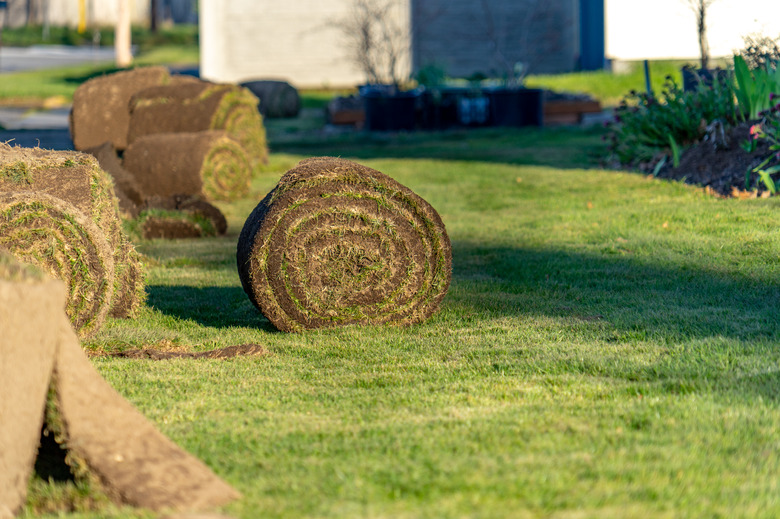How To Lay Sod For A New Lawn
We may receive a commission on purchases made from links.
Sowing grass seed to start an entire lawn from scratch requires a lot of patience while waiting for the grass to grow. If you don't want to wait the weeks or months it takes to establish a lawn from seed, lay sod instead. New sod offers the appearance of a lush green lawn almost immediately after setting it in place, but don't be fooled: Laying sod often takes more than a month for the roots to take hold in their new home.
How to Prepare Your Yard for Sod
How to Prepare Your Yard for Sod
Even with a brand-new home site on a property that has no grass, laying sod is a bit more involved than simply unrolling it, cutting it to size and placing it. The ground must be cleared of debris and the soil worked a bit and leveled before the sod comes into play. Walk around the yard and remove any rocks or debris that may cause problems for a rototiller.
- Call 811, the national call-before-you-dig phone line, to schedule a professional to mark the ground above any underground utilities.
- Till the soil 4 to 8 inches deep, which helps break up clay, compacted soil and the roots of any weeds or plant matter growing in the project area.
- Pick up any rocks, clumps of old weed roots or pieces of tree roots that may have been tilled.
- Till a couple inches of organic matter, such as compost or aged manure, into the existing soil to help loosen and enrich the soil.
- If the soil has too much clay in it, work in more organic matter to improve drainage. A little sand can also help to provide better drainage.
- Test the soil with a soil pH test kit from a local garden center; this helps determine whether the soil needs adjustments to its pH to create optimal growing conditions. New sod prefers soil with a pH between 6.0 and 7.5 in order to thrive.
If the soil pH is lower than 6, the soil is acidic. Amend it with something like lime to raise the pH. If the pH is too alkaline at 7.5 pH or higher, add gypsum or a product recommended by a local garden center since soil composition varies from one region to another. To eliminate the guesswork, your local cooperative extension service can advise exactly how much lime or gypsum you need to add.
Tip
Your new yard should be graded away from structures so excessive rain runs away from buildings. New sod adds about an inch of height to the existing soil level, so if necessary, remove some of the existing soil so it's an inch lower than the driveway and other pavement surrounding the yard. Level the soil following the yard grade by dragging the back side of a bow rake through the soil, removing or breaking large clumps as needed. Water the yard lightly after leveling it.
When to Lay Sod
When to Lay Sod
The best time to lay new sod is in spring or early summer, although you could lay sod at virtually any time of the year that grass grows. In spring, rainy conditions help ensure the soil stays moist. Autumn's cool weather is also easier on the grass than the scorching heat of a hot summer day. In hot, humid regions such as Florida, lay sod in May or even late April for the southernmost parts of the state. In a hot but somewhat dry region such as Arizona, fall is the better option after monsoon season ends but the grass still grows before its winter dormancy.
While you're waiting for the right season to work on the yard, take a good look at the area at different times of day to determine whether it's mostly in the sun, shade or some of each. If your yard has trees that drop leaves in the fall, study the yard when the leaves are on the trees to determine where the shade is located or at least make an estimate based on the shadow of the tree if you're new to the property, and the tree hasn't yet developed its spring foliage. This information comes in handy later when determining which type of sod is best for your yard. For instance, a grass variety that requires full sun won't do well if your yard is in the shade most of the day.
How to Source Sod
How to Source Sod
Research regional sod suppliers to find one that gathers the sod and delivers it the same day. The longer the sod sits after it's rolled, the harder it is for the grass to recover, so this is a case where freshness is crucial. Experts at your regional sod farms should also know which of their grasses have the best chances to thrive in your yard's conditions. Some suppliers also have a sod calculator on their website to help you determine just how much to order based on your yard's square footage.
For best results, contact the sod supplier ahead of time to ensure it has the sod in stock when you need it. This also offers you the chance to go over delivery details, as they'll need a place to set all the new sod once they deliver it. Ask about the size of the sod pieces as well. Some are in rolls 24 inches wide and 60 inches long, while Southern grasses might be in smaller pieces of only 16 inches wide and 24 inches long. Knowing what you'll get ahead of time can help you plan your project a bit better.
How to Lay Sod
How to Lay Sod
Plan on laying the sod the day it arrives if at all possible. A roll of sod starts composting itself from the inside out if left out too long, especially during hot weather.
- Set the first piece of sod along the longest straight structure or paved area touching your bare yard, leaving no gaps between the sod and the building or pavement.
- Smooth down the piece with your hands to remove any air pockets.
- Lay the next piece of sod directly after the first so it makes one long strip, continuing the process until you reach a structure, a tree or the end of your yard. Cut the sod with a sharp, clean knife as needed at the end of each row or around trees, flower beds or protruding sprinkler heads.
- Rake footprints out of the adjacent soil as needed and set the second row or column of sod next to the first so the pieces of sod touch completely along the sides without gaps and without overlapping.
- Stagger the ends of the sod pieces like bricks. You may have to cut the first sod piece of the second row to half its length to ensure the end doesn't line up with the first row's end piece.
- Keep setting sod in this manner with each subsequent row, staggering the ends of one row compared to the next while preventing gaps and overlaps between sod pieces.Water the entire sodded area within 30 minutes or so after completing the project using enough water to soak the old soil below the sod layer.
Tip
If the yard has a steep slope, it's best to align the rows of sod across the slope rather than from top to bottom down the hill, as heavy rain in the few weeks could cause soil to wash out from between the strips of sod. If you're concerned about the sod staying put as the new lawn takes hold, use a rubber mallet to tap two biodegradable sod stakes into each end of each piece of sod on the slope. Tap them to ground level so a lawn mower blade won't hit them. Another option to help the sod stay put even on flat land is to go over it with a walk-behind lawn roller twice, rolling it from different directions. This removes air pockets that could cause the grass to dry out.
Watering and Mowing New Sod
Watering and Mowing New Sod
Avoid walking on the lawn for a week or so as the sod establishes itself in your yard. You should also wait several weeks before allowing pets or kids to play on the lawn. Water the new lawn once a day during the first week, ideally early in the day so the sod has plenty of daylight time to absorb the water. In the second week, water every other day and then transition to twice a week. If the weather is hot and dry during these early weeks, water it up to once a day or as needed to keep it from browning.
Wait until the grass is at least 3 inches high and has been in place for at least 10 to 12 days before mowing. Set the mower blade height to cut no more than 1/3 of the grass height off the top, or 1 inch on a 3-inch-high lawn. Use a lightweight push-behind mower if possible during the first few mows rather than a heavy riding mower or lawn tractor, as heavy equipment could damage the sod as it takes hold. Avoid fertilizing new sod because the roots of the grass are too delicate to handle the chemicals.


